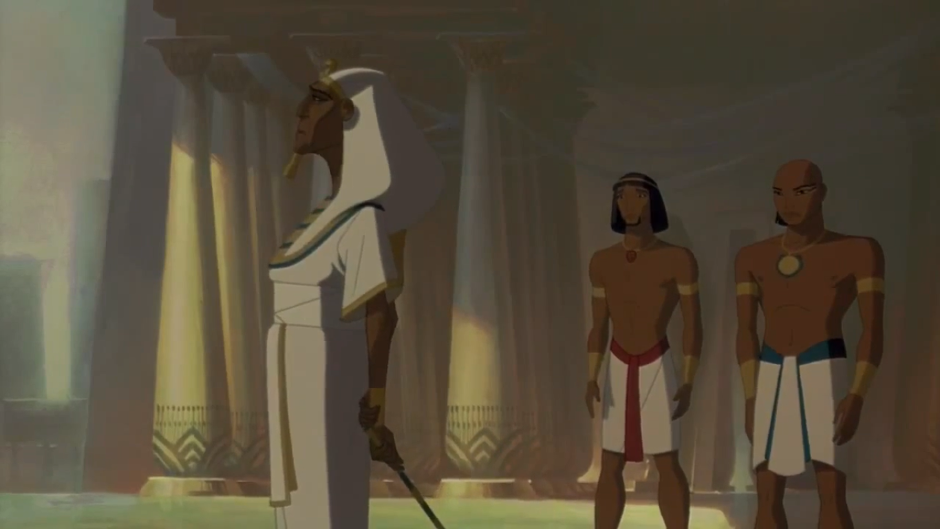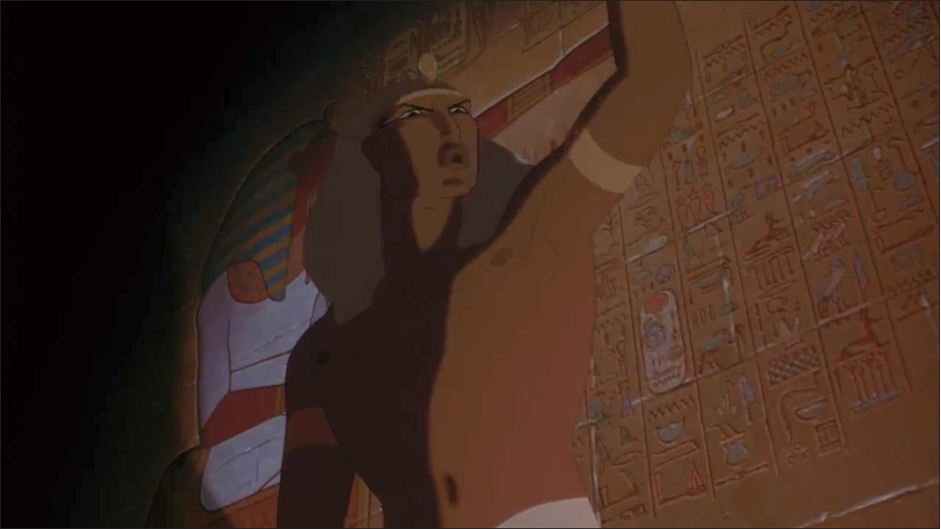It is certainly true that celebrity voice actors evoke their other roles through vocal performances and, by drawing on this wider intertext, a familiar voice helps to deepen our understanding of a character. My conception of celebrity vocal stardom necessarily requires a sense of the ‘celebrity’ – a big name who will be familiar to an audience, and whose voice is evocative of pre-existing performances. To demonstrate the value of the familiar voice, I want to contextualize Fiennes’ first animated villain, Pharaoh Rameses from The Prince of Egypt (1998), by evoking the intertext of his two then-biggest roles – the Nazi war criminal Amon Göth in Schindler’s List (1993), and Count Almásy, the title character in The English Patient (1996).
The film adapts the Book of Exodus, and follows the life of Moses from being a prince of Egypt to his ultimate destiny, leading the children of Israel out of Egypt. The Bible story does not specify the name of the Pharaoh, and our understanding that it was Rameses stems from the 1956 film The Ten Commandments. The animated version of Rameses is a considerably more sympathetic character than his live-action counterpart, and is torn between his loyalty to his family and the throne of Egypt, and his brotherly love for Moses. In a behind-the-scenes interview, Fiennes described the narrative as ‘a brothers’ story, really, of two brothers that fall apart and become estranged to the point where they’re completely opposite’ (Schaefer 1998).

The question of history and legacy features heavily in The English Patient, both on a personal and national level. Almásy’s only possession when he is admitted as the English Patient is a copy of Herodotus’ Histories, in which he includes his own photographs, drawings and notes – this book becomes a way for his nurse Hana to decipher certain information about his life. Much of Almásy’s story is paralleled by the tales in the Histories (Harrison 1998), and thus we can read him as a character shaped by his own story and influenced by history. This is true of Rameses too – he seeks to carve his own path as Pharaoh, but he is determined not to prove himself the ‘weak link’ who will ‘break the chain of a mighty dynasty’, to quote his father Seti. His desires put him in conflict with Moses, eventually leading to Rameses’ downfall.
As well as contextualizing Rameses, The English Patient connection also helps inform our reading of this animated film. The earlier film is largely set in Egypt, and the desert is a significant character in its own right – for Almásy, the desert is a space that allows him to be free of nations, while Moses finds it an escape from his responsibilities as a prince. Almásy is a character whose nationality is ambiguous, and the confusion over his identity is reflective of Moses’ journey in the first half of the film. That tension of identity leads to issues both for Almásy and Rameses as the world changes around them.

Rameses becomes a villain after Moses’ return to Egypt. Now Pharaoh, Rameses hopes that he can reconcile with his brother and go back to the way things were, but Moses tells him that God has demanded the Pharaoh frees the Hebrew slaves. Rameses’ contemptuous attitude to the Hebrews is given greater weight through Fiennes’ vocal work, which evokes his role as Amon Göth, an Austrian SS commandant of the Kraków-Plaszów concentration camp.
When Moses tells Rameses that their father’s hands ‘bore the blood of thousands of children’, Fiennes offers a dismissive noise before referring to them as ‘slaves’ – his tone suggests he does not value their life one bit. Similarly, as the Plagues begin to devastate Egypt, Moses visits Rameses and asks him to free his people once more. Fiennes’ voice is full of anger as Rameses says ‘you Hebrews have been nothing but trouble. My Father had the right idea about how to deal with your people, and I think it’s time I finished the job’. Fiennes’ familiar voice imbues this dialogue with the implied threat of extermination and works to ground the villainy of a character who through a large part of the film was sympathetic.

Drawing on these two roles, Fiennes’ vocal performance in The Prince of Egypt helps to layer Rameses’ character – the Pharaoh is both a monstrous tyrant with a casual disregard for lives he considers below his own, but he is also a brother concerned with his love for family and legacy. His existing star image thus informs how the viewer understands Rameses, and demonstrates the value in how a celebrity voice shapes our interpretation of animation. This is not a new concept by any means, and my next two posts will explore how the celebrity interacts with and complements the voice to develop my theory of celebrity vocal stardom.
References
Harrison, Thomas (1998). “Herodotus and The English Patient.” Classics Ireland, 5, pp. 48-63.
Schaefer, Christen Harty (1998). “The Making of The Prince of Egypt.” YouTube, https://www.youtube.com/watch?v=B_aWmJJZj6Q
Reece Goodall is a PhD student at the University of Warwick, working on an industrial, cultural and theoretical analysis of French horror cinema. His research interests include horror cinema, genres, transnational genres, and authorship as well as the interplay between popular media, news, and politics.
